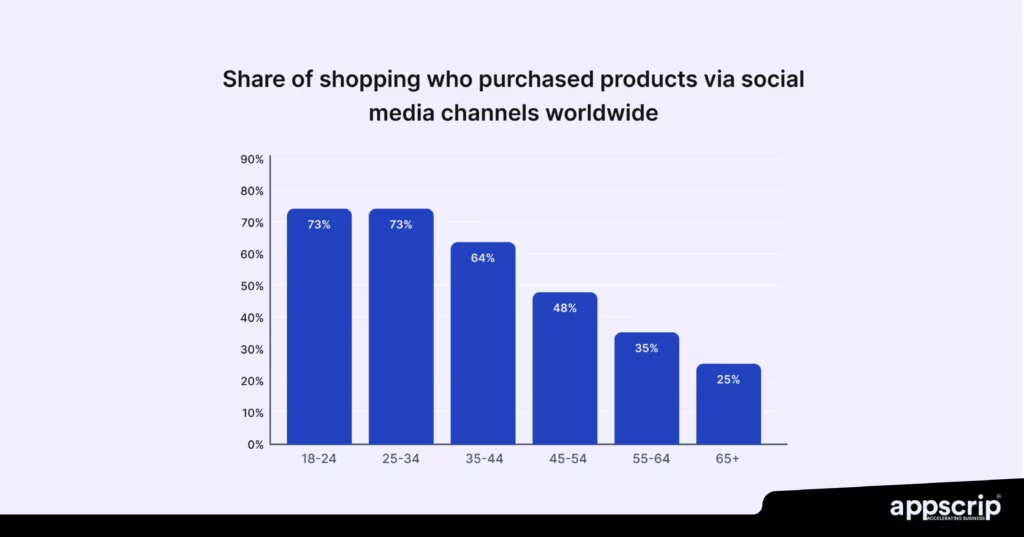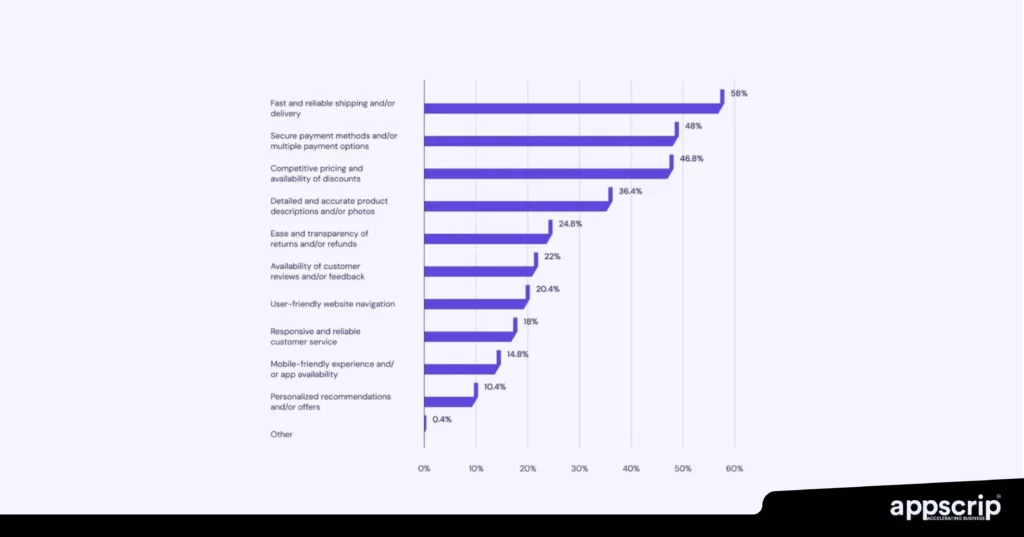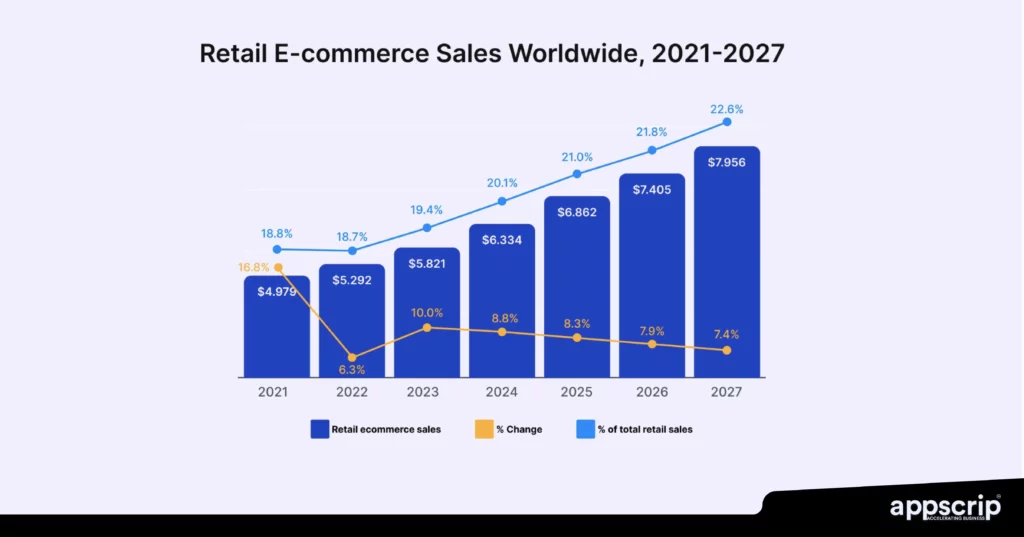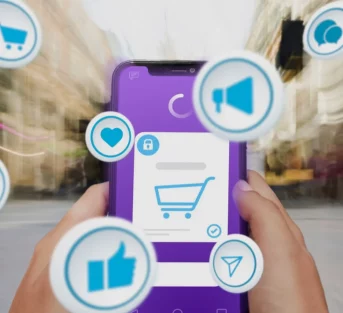This year the global ecommerce sales should breach $6.88 trillion and by 2027 $8.03 trillion. 80% of this will be from Asia and the U.S. That being said, having a basic online store will not suffice. Businesses will need feature-rich apps to deliver flawless, efficient, and personalized shopping experiences.
To stay counted in this dynamic niche, it’s essential to not just include fundamental functionalities but also advanced and novel features that enhance user experience and operational efficiency.
Read on as we break down the ultimate set of ecommerce app features every modern eCom app should possess. We’ll explore essential building blocks, powerful advanced tools, and emerging innovations that will ensure your app grabs eye-balls in this chaotic digital marketplace.
TL;DR
Key Stats & Trends
- Global eCommerce sales to reach $6.88 trillion in 2025 and $8.03 trillion by 2027.
- Of this 80% of sales will come from Asia and the U.S.
- Basic online stores won’t cut it—feature-rich apps are essential.
Core Features
- User Accounts: Secure logins (OTP, social logins), personalization (wishlists, purchase history).
- Product Catalog: High-quality images, smart search (voice/auto-suggest), advanced filters.
- Checkout: Multiple payments (cards, BNPL, UPI), guest checkout, easy cart editing.
- Order Tracking: Real-time updates, push/SMS/email notifications, delivery ETA.
Advanced Features
- AR/VR: Virtual try-ons, 3D product visualization.
- AI/ML: Personalized recommendations, predictive analytics, AI chatbots.
- BNPL: Flexible payment options via Klarna, Afterpay, etc.
- Security: PCI compliance, end-to-end encryption, fraud detection.
Admin & Analytics
- Backend Dashboard: Inventory management, customer support tools.
- Analytics: Behavior tracking, sales reports, conversion optimization.
Emerging Trends
- Voice Commerce: Voice search ordering (e.g., Walmart via Google Assistant).
- Sustainability: Carbon footprint calculators, ethical sourcing badges (e.g., Amazon’s Climate Pledge).
Core Online Shopping App Features
User Accounts and Profile Management
Creating a seamless and secure user account is rudimentary to building trust and bringing repeat purchases.
🔐 Secure Login Systems
- Email & Password: Traditional and basic yet essential, ensuring data encryption and secure backend validation.
- OTP-based Login: Just the right sauce for mobile-first markets, offering smooth and password-free authentication.
- Social Logins: Integration with platforms like Google, Facebook, and Apple accelerates onboarding and reduces drop-offs.
🔗 Social Media Integration
- Enables quick login/signup. Now users can even share purchases, reviews, or wishlists on social platforms.
- Enhances brand visibility and fosters social proof.
🧠 Personalization Options
- Wishlists: Users can save items for later, ensuring sales and boosting re-engagement.
- Purchase History: This is one of the easiest ways to reorder past items where businesses can even include product recommendations.
- Saved Addresses & Preferences: Future checkouts are made super easy, improving user experience.
| Ecommerce Category | Estimated Sales in 2024 |
| Consumer electronics | $922.5 billion |
| Fashion | $760 billion |
| Food and Beverages | $708.8 billion |
| DIY and Hardware items | $220.2 billion |
| Furniture | $220.1 billion |
| Media | $193.9 billion |
| Beauty and personal care | $169.6 billion |
Product Catalog and Search Functionality
A well-thought and exhaustive product catalog can help users browse and easily find what they need.
🖼️ High-Quality Product Images and Descriptions
- Images: High clarity pictures, multiple angles, zoom-in views, and lifestyle photos build confidence in product quality.
- Descriptions: Clear, concise, and SEO-optimized content (specifications, size guides, material, etc.).
🗂️ Categorization and Advanced Filters
- Categories & Subcategories: Vital to have logical hierarchy based on product type, use, or brand.
- Filters: Should help locate product using price, color, size, rating, brand, availability, discount, and delivery time.
- Faceted Navigation: Users should be able to apply multiple filters in-one-go.
🔍 Smart Search with Auto-Suggestions
- Type-Ahead Suggestions: Auto-filling to provide product suggestions as users type, enhancing speed and discovery.
- Synonyms & Misspellings Support: This is to help fathom user intent even with spelling errors.
- Voice Search (Optional): Emerging trend for hands-free product discovery.
Shopping Cart and Checkout Process
The cart and checkout flow must be smooth and free-flowing to prevent cart abandonment and help drive conversions.
🛒 Easy-to-Edit Cart
- Users should be able to add, remove, or modify ordered quantities easily.
- Item thumbnails, price details, discount applications, and delivery info should be conspicuous.
💳 Multiple Payment Options
- Cards: Debit, credit, and prepaid cards with PCI compliance.
- Digital Wallets: PayPal, Apple Pay, Google Pay, Amazon Pay, etc.
- UPI/QR Code Payments: This is imperative in emerging markets (like India).
- BNPL (Buy Now, Pay Later): Flexible credit options via third-party services will help enhance sales.
🧾 Guest Checkout Feature
- This feature will help new users complete purchases without mandatory registration ensuring sales, and customer satisfaction.
- Offers a follow-up prompt to create an account post-purchase to retain the user.

Order Tracking and Customer Notifications
Post-purchase visibility is imperative for enhancing trust and assuring customers that they’re in professional hands. This cuts anxiety.
📍 Real-Time Order Tracking
- Live Tracking: Users feel in control when they can see the status of their order (e.g., packed, dispatched, out for delivery).
- Map View: For on-demand and same-day delivery models, real-time location of the delivery agent can be displayed.
- Estimated Delivery Time: Dynamically updated ETA based on traffic, distance, and logistics data.
🔔 Push Notifications, SMS, and Email Updates
- Push Notifications: Instant alerts for order status, offers, cart reminders.
- SMS & Email: This is key for transactional updates and users who are offline.
- Customizable Notification Preferences:
This gives users control over how and when they receive notifications, improving shopping experience and building long-term brand trust.
- Users can choose updates as in: order status, promotions, price alerts, etc.
- Preferred communication channels can be selected individually.
- Frequency settings to prevent disruption and enhance comfort.
- Personalized settings reduce notification fatigue and ensure greater user engagement and loyalty.
🚚 Delivery Status and ETA Display
- Produce clear timelines with stages – Order placed, Shipped, Out for delivery.
- Dynamic updates improve post-purchase experience and reduce support tickets.
Top factors that motivate people to shop online:
| Free delivery | 50.60% |
| Coupons and discounts | 39.30% |
| Easy return policy | 33.20% |
| Simple online checkout | 30.60% |
| Customer reviews | 30.50% |
| Next day delivery | 30.40% |
| Loyalty points | 27.20% |
| Cash on delivery | 19.80% |
| Social likes and comments | 19.40% |
| Eco-friendly credentials | 18.90% |
Advanced Features to Enhance User Experience
Augmented Reality (AR) and Virtual Reality (VR)
Giving customers higher visibility helps. AR and VR integrations do just that. They also redefine how users interact with products, particularly in categories like fashion, furniture, and electronics to ensure their choice is right.
🧍 Virtual Try-Ons for Apparel, Furniture, etc.
- Apparel & Accessories: Users can “try on” clothes, glasses, or makeup through their device’s camera. This reduces the chance of returns.
- Furniture/Home Décor: Apps like IKEA Place let users visualize how products would look in their space at actual scale, improving buying confidence.
🌀 3D Product Visualization
- Enables users to interact with lifelike 3D models — rotating, zooming, or viewing from different angles.
- This is really useful when checking out gadgets, jewelry, or any product where detail and dimension matter.
- Creates an immersive experience, increasing user engagement and session time.
AI and Machine Learning Personalization
Artificial Intelligence (AI) and Machine Learning (ML) bring about smarter eCommerce apps. They analyze behavior, preferences, and trends to bring about a supremely-personalized shopping journey.
🎯 Personalized Product Recommendations
- User data like search history, clicks, purchase behavior help suggest products that can be relevant to them.
- Increases average order value (AOV) and repeat purchases.
- Can be implemented through collaborative filtering, content-based filtering, or hybrid models.
📊 Predictive Analysis for Customer Behavior
- AI predicts what a customer might want next — e.g., restock reminders for consumables or curated collections based on seasonality.
- Supports inventory planning and campaign targeting with greater precision.
🤖 AI Chatbots for Instant Support
- Available 24/7 to answer FAQs, tracking orders, or initiating returns.
- Complex issues can be escalated to human agents via live chat integration.
- Cuts traffic to support teams while improving resolution time and customer satisfaction.
Buy Now, Pay Later (BNPL) Options
BNPL functionality is becoming the magic-button for modern eCommerce platforms, especially in markets where users seek financial flexibility.
💸 Benefits of Flexible Payments for Customers
- Allows users to split payments into interest-free instalments (or defer payments).
- Attracts budget-conscious shoppers and increases conversion rates for high-value items.
- Builds trust and loyalty, especially among younger demographics.
🔌 Integration with Providers like Klarna, Afterpay, etc.
- Plug-and-play APIs and SDKs make it relatively easy to offer BNPL through leading fintech providers.
- Ensures compliance, risk management, and smooth processing of transactions.
- Typically revenue-shared or fee-based, but worth the upside due to increase in sales uplift.

Most important elements users look for while shopping online
Security and Payment Gateways
In eCommerce, users are very circumspect of the safety of their data, nothing kills conversions faster than this. Today’s customers want convenience and Z-Level security when it comes to online payments.
Here’s what your app should offer to keep both users and data protected:
🔐 Secure Payment Processing
💳 PCI DSS Compliance
- Adheres to global security standards for handling cardholder data
- Minimizes risk of data breaches and boosts customer trust
- Regular updates and audits ensure ongoing compliance
🔒 End-to-End Encryption
- Encrypts user data from when it’s entered to the moment it’s processed
- Prevents sensitive info (like card numbers or passwords) from being intercepted
- Essential for protecting data on both web and mobile platforms
🤝 Integration with Trusted Payment Gateways
- Supports reliable payment partners like Razorpay, Stripe, PayPal, etc.
- Allows for multiple payment methods: credit/debit cards, UPI, wallets, BNPL, etc.
- Helps ensure fast, smooth, and secure transactions with minimal downtime
🛡️ Fraud Detection and Prevention
🔐 Multi-layered Authentication
- Includes layers of security like OTPs, biometrics, or 2FA
- Helps verify user identity and prevents unauthorized access
- Critical during checkout and payment processes
⏱️ Real-Time Fraud Detection Systems
- Uses machine learning to flag suspicious activity in real-time
- Can detect anomalies like unusual transaction patterns or IP mismatches
- Reduces chargebacks and protects your revenue
⚠️ Risk Scoring and Alerts
- Risk levels are assigned to transactions based on behavior, device, and geography
- Sends instant alerts for high-risk actions
- Helps the admin team take quick action before a breach or scam occurs
Security isn’t just a backend feature—it’s a priority that builds user confidence. By integrating secure payment options and strong fraud prevention systems, you safeguard transactions and value customers’ trust. In a space where one bad experience can lead to churn, this is something you shouldn’t overlook.
| eCommerce Platform | Estimated Ad Spending |
| Amazon | $1700 Million |
| Target | $603.9 Million |
| Walmart | $414.6 Million |
| Home Depot | $166.3 Million |
| eBay | $112.5 Million |
| Etsy | $88.5 Million |
| CVS | $41.3 Million |
| Bestbuy | $33.3 Million |
| Lowes | $17.2 Million |
| Aliexpress | $0.32 Million |
Admin and Analytical Features
The success of an eCommerce app rides not just alone on what the user sees—it’s also about what’s going on behind the scenes. An efficient admin panel and well-laid out analytics setup can make all the difference.
The combination of these two not only keep things running smoothly behind the scenes but also provide the insights you need to grow faster and smarter. Whether you’re managing inventory, supporting customers, or digging into data to boost conversions, these app features for online businesses give you the control and clarity to scale.
Here’s what to look for:
Admin Panels and Content Management
✅ Easy-to-Use Backend Dashboard
- A clean, intuitive dashboard makes everyday operations simple and efficient
- Mobile-friendly design for on-the-go access
- Custom widgets and role-based permissions to suit different needs
- Real-time updates for everything from orders to customer issues
📦 Product & Inventory Management
- Effortlessly add, update, or remove products
- Track stock levels in real-time and set low-stock alerts
- Bulk upload options to save time
- Sync inventory across multiple sales channels (like web, mobile app, and physical store)
🛎️ Customer Support Management
- Centralized view of customer queries, returns, and complaints
- Integration with tools like Zendesk or Freshdesk
- Assign support tickets, track resolutions, and monitor customer satisfaction
- Optional chatbot integration to handle basic queries automatically
Analytics and Reporting
📊 Customer Behavior Analytics
- This is to understand how users interact with your app—where they tap, what they skip
- Helps spot popular products and track browsing habits
- Use heatmaps and session recordings to visualize user journeys
- Identify where users drop off and work out why
📈 Sales Reports & Funnel Tracking
- Access detailed sales reports—daily, weekly, monthly, or custom
- Track top-performing products and categories
- Funnel analysis to understand drop-offs at each stage (from product view to purchase)
- Helps fine-tune marketing and UX strategies
🚀 Conversion Rate Optimization (CRO) Insights
- Identify what’s working and what’s not when it comes to turning visitors into buyers
- Analyze product pages, checkout flow, and bounce rates
- Run A/B tests to see what drives more conversions
- Get AI-driven suggestions to improve CTAs, images, and overall layout

Emerging Trends in eCommerce Apps
Voice Commerce & Chatbots: The Conversational Future
1. Voice Search & Product Ordering
- Market Growth:
- By 2025 half of all searches will be voice-based (Comscore).
- Voice shopping to touch $40+ Billion in the U.S. by this year (OC&C Strategy Consultants).
- Key Implementations:
- “Hey Siri, reorder oat milk”: Apps will integrate with Alexa/Google Assistant for hands-free / voice-based purchases.
- Localized voice search: Optimize for natural language queries (e.g., “Where can I buy yogurt near me?”).
- Example:
- Walmart’s Voice Order: Customers add items to cart via Google Assistant.
2. Conversational Shopping Assistants (Chatbots & AI)
- Stats:
- 70% of shoppers prefer chatbots for instant replies (Salesforce).
- AI chatbots cut customer service costs by 30% (IBM).
- Use Cases:
- Personalized recommendations: “Based on your last order, try this keto snack!”
- Seamless returns: Chatbots automate refunds via order ID scan.
- Tools:
- ChatGPT-4o, Dialogflow, or custom NLU models for contextual understanding.
B. Sustainability & Ethical Shopping: The Green Imperative
1. Carbon Footprint Calculators
- Why It Matters:
- It has been noticed that 66% of consumers are ready to pay more for sustainable brands (McKinsey).
- Apps like Klarna show emissions per purchase for the environmentally conscious
- Implementation:
- Partner with EcoCart or CarbonClick to offset shipping emissions.
- Display badges: “This order is 100% carbon-neutral.”
2. Product Sourcing Transparency
- Blockchain for Traceability:
- IBM Food Trust: Tracks farm-to-shelf journey (used by Carrefour).
- Everledger: Certifies ethical diamonds/electronics.
- UI/UX Tips:
- Add a “Source Story” tab per product (e.g., “Cotton sourced from Fair Trade farms in India”).
3. Highlighting Eco-Friendly Brands
- Strategies:
- Green filters: Let users sort by “Vegan”, “Plastic-Free”, or “Upcycled”.
- Loyalty rewards: Extra points for choosing sustainable options.
- Examples:
- Amazon’s Climate Pledge Friendly tag.
- ThredUp’s “Clean Out Kit” for recycling clothes.
Key Takeaways for Businesses
- Voice/Chatbots: Reduces effort in shopping; invest in NLP.
- Sustainability: Transparency = trust. Use APIs (e.g., EcoCart) to quickly win customers over.
- Competitive Edge:
- Early adopters of voice commerce gain SEO advantages (voice search ≠ typed keywords).
- Gen Z/Millennials drive 75% of ethical shopping demand (First Insight).
Examples of apps that have jumped the bandwagon?
- Voice: Starbucks (Alexa orders)
- Sustainability: Pact (ethical apparel), Too Good To Go (food waste reduction)
Conclusion: eCommerce App Features
To build a successful eCommerce mobile app in 2025, you got to core functionalities, advanced tools, and emerging innovations. From a flawless user experience to efficient backend controls and the much needed security, each feature plays a critical role in ensuring growth and customer loyalty.
But remember, launching the app is just the first stage, staying competitive means continuously evolving, taking user feedback, and adapting to new trends and technologies. Whether you’re building from scratch or scaling an existing platform, begin by gauging your feature set and implement what matters.
Grow your eCommerce app by giving what users need today—and what they’ll expect tomorrow.





